Herbivore deterrence by early land
plants
There are seven species of early land plants known from the
Rhynie chert. Two of them, Trichopherophyton
and Nothia,
deter herbivores by quite different means. The means of Trichopherophyton
is
obviously mechanical: A combination of short and long pointed bristles
would frustrate any crawling creature trying to get at the sporangia
with the nutritious spores (Fig.1).
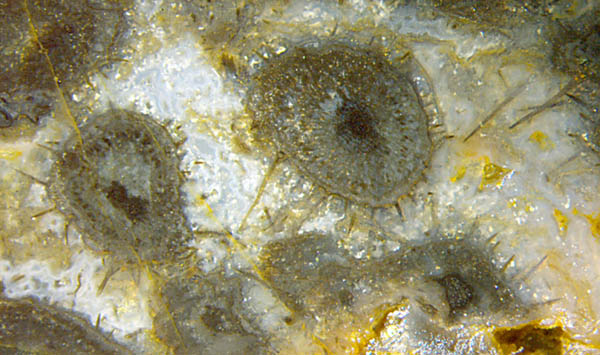


Figs.1-3: Trichopherophyton
cross-sections, same scale, frame widths 8.5, 5.5, 4 mm).
Lots of short bristles and a few stiff long ones
are present in Fig.1. The
length of some bristles may exceed the diameter of the shoot: Rhynie Chert
News 95 .
The quite unusual formation in Fig.2
looks like an intimate contact of yet unseen creatures with tentacles:
Two unlike specimens of Trichopherophyton,
the bigger with tentacles
waving about,
the smaller with short ones
around its surface, had grown, while clinging together, in a
water-filled cavity in
the silica gel.
Subsequently, silica gel did not only accumulate
in their tissue but also outside so that the two specimens became fused
into a common solid cylindrical column still free-standing in the
cavity, with quartz crystals around, as still seen in Fig.2
with a dark shadow on the right indicating a gap left over from the
original cavity. It would be
interesting to know whether this formation is purely incidental or
rather hiding a secret.
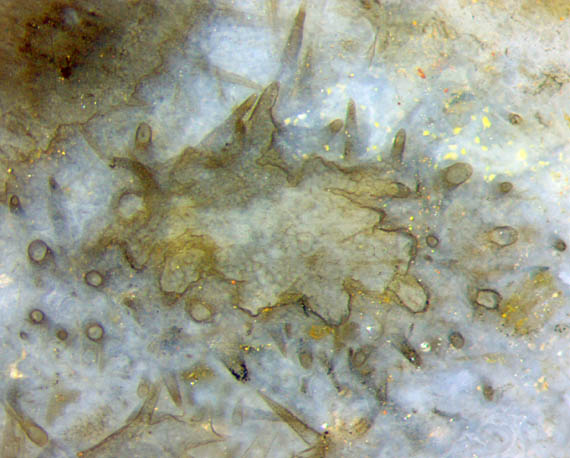
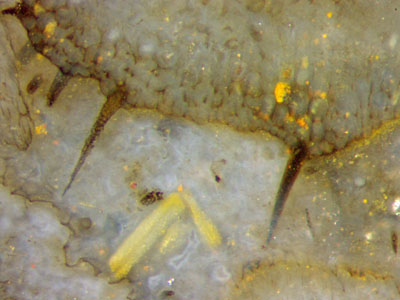
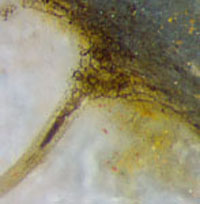
Figs.4-6: Trichopherophyton
cross-section details,
same scale,
frame widths 2, 1.4, 0.7 mm.
Magnification 4 times that of Figs.1-3.
Like the sizes of the bristles, their connection
to the
epidermis cells is variable. Long bristles emerge from broad bases
often filled with
small cells (Fig.6) with sizes comparable to those of the smallest
epidermis cells
in Fig.5. Of similar sizes are some faintly seen meshes on
a
Trichopherophyton
tip cross-section in Fig.4.
The left one of the two bristles in Fig.5 seems to consist of
tiny grains much smaller than the cells.
It may be mentioned here
that microbial colonies
in decaying organic
matter can make
unexpected
structures known as pseudo cells:
Rhynie
Chert
News 112.
This phenomenon will be considered with repect to Trichopherophyton in
a separate contribution
Surprisingly different from the mechanical means of
deterrence as applied by
Trichopherophyton
is the subtle
means of hidden poison in Nothia.
Fig.7: Two spore capsules of Nothia
incidentally cut such that the
essential features are seen. Frame width 4.3mm.
Fig.8: Drawing related to Fig.7
Fig.9: Nothia
cross-section with big tubes between small cells near the boundary.
Frame width 4mm.
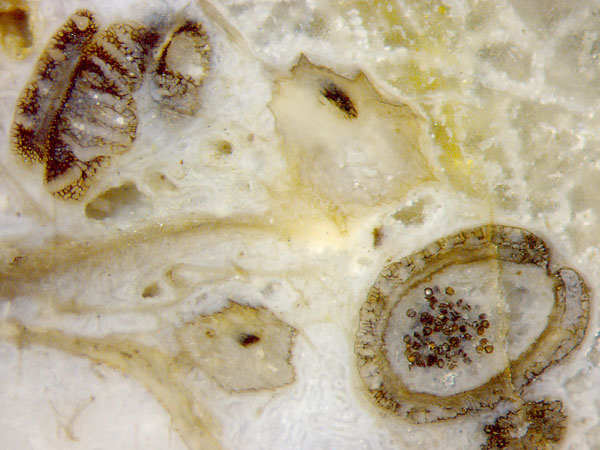
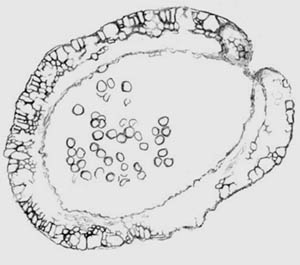
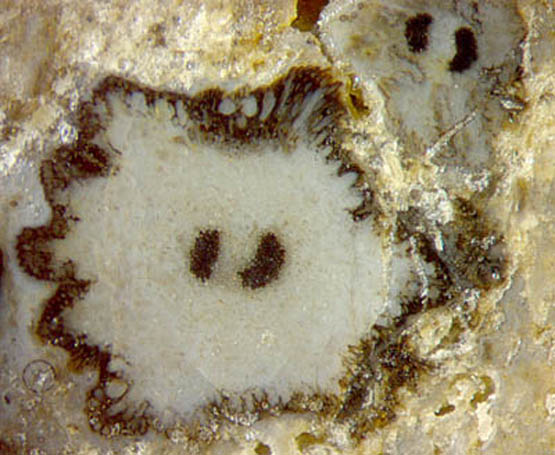
As a highly improbable coincidence, the chert
sample in Fig.7 has been cut such that two sporangia
are seen on the cut face with the essential features clearly
visible. The object below right is easily recognised as a capsule
with complex wall structure and an opening above right.
This opening is really a
curved slot running over a larger part of the capsule so that it can
appear
as a narrow gap between two parts of
the capsule above left. (See
Rhynie
Chert News 110.)
Incidentally this capsule
is cut such that big
tubes, cut across or lengthwise, are clearly seen on the two lids.
The tube cross-sections on the sporangium section below right
are less distinctly seen but highly interesting. A very few of them
reveal faint residues of a decayed cellular structure inside: in Fig.8
near the top of the drawing. This faintly seen residue had given rise
to the suspicion that the big tubes are no giant cells for water
storage as generally assumed [1] but vessels designed for a more
sophisticated purpose.
The recent euphorbias
make long tubes from ordinary cells by dissolving cell walls with the
purpose of storing a sticky poisonous milk there. Probably Nothia had invented
the same trick of
tubes releasing deterrent liquid if tapped by creatures trying to get
at the tasty spores. The surface
tension of liquids can be dangerous to small
creatures which are not
able to free themselves from a drop. A tube under pressure would spill
its
liquid content profusely
and soil the biting creature with possibly fatal
effect [2]. Also it can be assumed that Nothia, too, had
stored a repulsive liquid in its tubes.
Samples:
Rh3/18.4: found in 1998,
Fig.9;
Rh2/21 (2.8kg): found in 2001, Part2,
Fig.7;
Rh15/78.2: obtained from Barron
in
2014, Figs.1,3,5,6;
Rh14/18.2,3: obtained
from Barron
in
2007: Figs.2,4;
H.-J.
Weiss 2021
[1] H.
Kerp, H. Hass, V. Mosbrugger: New data on Nothia aphylla,
in:
P.G. Gensel, D.
Edwards (eds.): Plants Invade the Land, N.Y. 2001.
[2] Rhynie
Chert News 33
 |
 |
170 |












